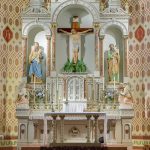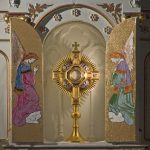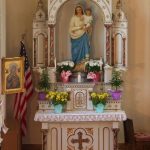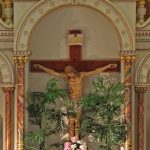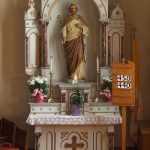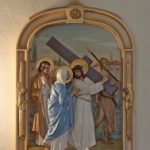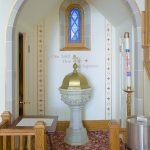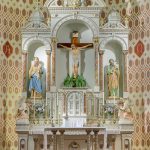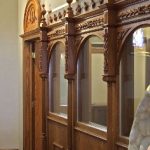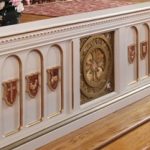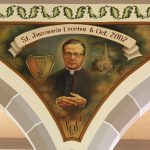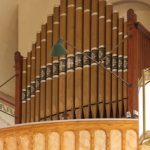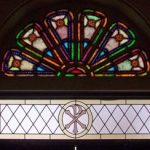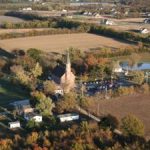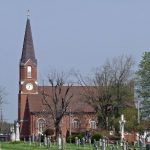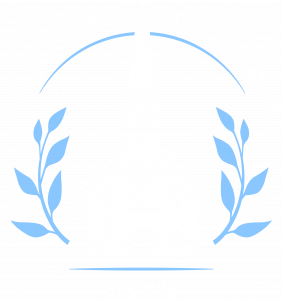St. Joseph History
St. Joseph has a long history dating back to the 1800s. Read the full story below and view the gallery of church pictures.
The community now known as Josephville began in the early l800s as a mail stop and mercantile known as Schmuckers Store in Allen’s Prairie. The land was ceded through a Federal Grant under President Martin Van Buren by Joseph Allen in about 1837. Allen settled on a farm and, along with a group of other French and English settlers from the Virginias, made improvements to the land, erected buildings, then sold the land and moved on. The majority of permanent settlers were German immigrants who were able to purchase the land for $1.25 per acre.
One of these immigrants was Anton Kersting, who purchased the Allen property. In 1848 a parish began to organize when Kersting held church services in his log home, a home which stands today on Hwy P. It was about this time that the area began to be known as Josephville.
In 1852 Kersting donated 10 acres of farmland to the congregation for a parish. A log church, 26 by 59 feet, was constructed. The first pastor of record was Father John Beotzkes. The first baptism occurred in 1857 with the christening of Gerald Brune, son of Christopher Brune and Katherine Kuhlmann.
Construction of the parish rectory begin 1857, but the building burned down one Sunday morning during High Mass.
Father Conrad Tintrup arrived in 1858 and rebuilt the house, He also constructed a school and a teacher’s home in 1859. The brick school was eventually converted to a Sister’s house.
Father Theodore Krainhardt came to Josephville in 1868, and in 1870 the cornerstone for a new church was laid. Construction continued through 1872.
St. Joseph Church has been referred to as “the oldest homemade church in the area”. This is because clay for the bricks was dug from “the brick yard pond,” an area of red clay on the farm located across the road from the church. The bricks were baked “on the spot” on Leonard Rothermich’s farm at a cost of $4 per thousand. Lumber for the church floors and communion rail came from the trees of parishioners’ farms.
Local masons and carpenters performed the work, and on October 6, 1872, the new church was dedicated by Rev. Henry Muehlsiepen, Vicar General of the Archdiocese of St. Louis.
Father Krainhardt retired in 1899 and died in 1902. He is buried in the church cemetery. Father Anthony Acker was named pastor in 1900 and served St. Joseph Parish for 21 years. During that time the church received its first central heating system. It was also during the time of Father Acker’s service to the parish that one of the most outstanding feats by the parishioners was accomplished. The foundation under the front part of the church had, over the years, begun to weaken and the steeple began to lean. Men of St. Joseph Parish, with supervision from a St Louis firm, but without advanced equipment, literally pushed the steeple back into place and reinforced the foundation at the same time.
In 1922 Father Christian Schlefers was named pastor. He died suddenly in June of 1924. During his administration a larger and more modern brick school building was erected and electricity was installed in all the parish buildings.
Father Schlefers was succeeded for one year by Father Bernard Groner. Father John Lakebrink served as administrator for several months, and that same year Father John Schramm became the 7th St. Joseph pastor. During this time he celebrated his golden and diamond jubilee as a priest. He died in 1950 at the age of 94.
Father Julian Meyer came to St. Joseph in 1943 and in May of 1947 the northwest corner of the church was struck by lightning. Six weeks later a tornado struck the same corner. The church was badly damaged and, at first, it was thought that it could not he repaired. After some deliberation, it was decided to proceed with repairs. Once again, lumber was donated from parish farms. At this time, the church was completely redecorated.
Father John Wieberg was the 9th pastor, serving from 1950 to 1961. Father Richard Gallagher came in 1961 and served as administrator for two years. Father Clarence Krull came to St. Joseph in 1963 and during his service he established the parish quilt club, reintroduced the parish picnic, which had been discontinued, and moved the altars in church forward after Vatican II. The parish celebrated the 100th anniversary of the church building in 1972.
In 1973 Father John Houlihan came to St. Joseph as pastor and served for two years. In 1975 Father Joseph Eilers became pastor. In 1985 Father Albert Schmaltz became St. Joseph’s 13th pastor. Father Schmaltz made many improvements to the parish facilities including central air conditioning for the church, additional restrooms for both the church and the school, and a computer center in the school building. Father Schmaltz also modernized the church bells, which now ring on an electronic timer. He replaced the church pews, added a cry room, and put a new roof and copper gutters on the church. He began work on the grotto at the entrance to the cemetery.
Father Schmaltz also directed the restoration of the mural above the altar. The mural, as the story goes, was originally painted by a traveling artist who appeared unsolicited and offered to paint the domed ceiling. After completing the work, the artist left the area before the negotiated fee could be paid and without signing the painting. This generous artist remains anonymous today, lending an air of divine origination to the painting. This otherwise traditional Catholic image of the Death of St. Joseph is reflected upon by the St. Joseph Parish faithful each day. In 1991, Fr. Schmaltz commissioned a restoration of the painting. This work was performed by parishioners James Hakenwerth, who restored the plaster surface, and Linda Wilmes, who restored the painted image. It is a faithful re-creation of the original work of art. Father Schmaltz retired in 1994 and passed away in November 2001. He currently rests in the parish cemetery.
Father Raymond Liermann came to St. Joseph in 1994 and served for three years as pastor, until his retirement in 1997.
June 1997 saw the arrival of Fr. Timothy Elliott. Father Elliott installed air conditioning in the school buildings, renovated the convent into classrooms and a computer room, completely renovated the rectory and restored the church interior to it’s current beauty as shown in these photos.
St. Joseph’s 16th Pastor, Father Larry Huber was installed in July of 2006. In 2008, the parish broke ground for the new school building. The beautiful modern facility was dedicated by Fr. Huber in 2009.
Father Bob Samson came to St. Joseph in 2013 and oversaw major restoration and maintenance projects on the church and church grounds. After his retirement in 2023, Father Joseph Post became the 18th Pastor of St. Joseph.


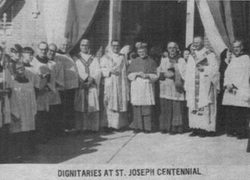
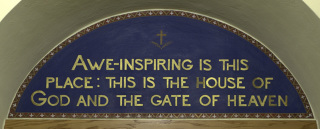

Photo Gallery
- The Nave and Sanctuary of St. Joseph Church
- The Monstrance
- Mary’s Altar
- The Crucifix, decorated for the Easter season
- The St. Joseph Altar
- The Stations of the Cross
- The Baptismal Font
- The Main Altar
- The ornate Confessional doubles as a cry room during church services.
- The sanctuary is guarded by this beautiful communion rail, commissioned by Fr. Elliott and detailed by parishioner Linda Wilmes in 2006.
- The gussets of the arcade arches which support the vaulted ceiling of the church are adorned with murals depicting modern saints, such as Jose Maria Escriva, the founder of Opus Dei, shown here.
- The Seventeen Gilded Frontpipes of the 1903 J.G. Pfeffer & Son Pipe Organ
- A stained glass window found near the entryway adorned with the Chi-Rho, or Labarum Christogram. “In hoc signo vinces” (“In this sign you will conquer”).
- Arial view of St. Joseph Parish
- Exterior and Cemetery

